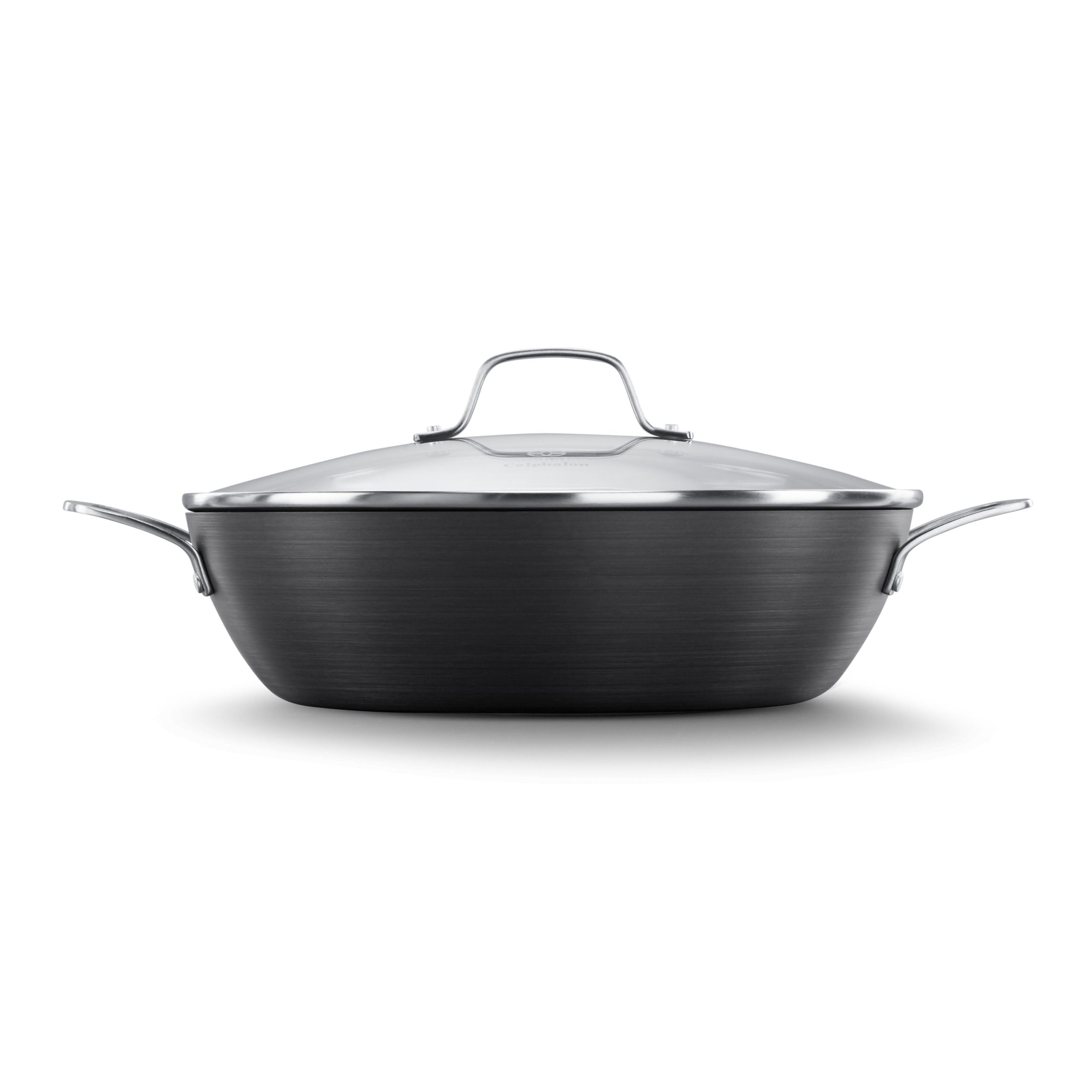Deep frying at home can often seem like a daunting task. Extremely hot oil and a LOT of it, searing hot oil splashing and splattering everywhere, burned bits of batter collecting at the bottom of the pan ruining your oil before your food is done cooking…the list goes on and on. Luckily for you, we’ve put together a short guide on how to choose the Best Pan for Deep Frying at home.
One important note before we continue, though.
Deep frying at home will always be a bit of adventure, there’s going to be no way around that. Don’t let it daunt you though, deep frying at home with the pots and pans you have on hand can be well worthwhile and of course, completely delicious.
But there is one huge difference between commercial deep fryers and deep frying at home.
Commercial deep fryers that restaurants use (the big silver boxes with long-handled baskets on them) have their heating elements on the sides of the oil wells, not at the bottom. When you’re deep frying at home in pots and pans, your heat source will always be on the bottom.
The issue with having the heat source on the bottom is that, inevitably, bits of food will fall off during the cooking process and collect at the bottom of the pan where the heat is the highest and eventually burn.
In commercial deep fryers, the wayward bits of food will fall through to the bottom of the oil, where the temperature is the lowest. They won’t burn nearly as fast and make it possible to use the oil for much longer than if the heating element was at the bottom.
You’ll definitely notice black specks forming when you deep fry at home, but you can get more mileage out of your oil but making sure to strain it after you’re done or using a spider skimmer to get the burned bits out. This way, you can freely reuse your frying oil for multiple batches or meals before it takes on too much of burnt flavor and save yourself some money on oil.
Now, on to our guide to the Best Pan for Deep Frying at Home.
Deep Frying Pan
By deep frying pan I don’t mean a pan for deep frying (though that’s what we will be doing with it, of course) but just a frying pan that’s deep.
This is probably going to be the choice with the most potential options, if you don’t already have one at home.
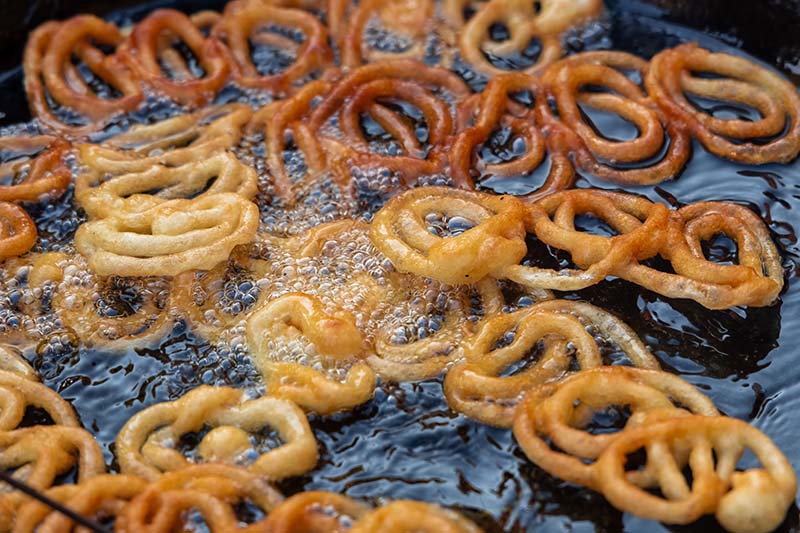
Something like the Calphalon 12 inch Nonstick All Purpose Pan or this Cuisinart 14 inch Stir Fry Pan both fit the bill nicely.
Calaphon 12″ Nonstick All-purpose Pan
The high volume pan has tall sides that allows to hold large quantities of oil. The pan also comes with a lid which has the dual benefit of both trapping heat in, so that the oil heats up faster, and acting as a splatter shield to prevent popping frying oil from getting on your cooking surface or stovetop.
In many ways, these pans are just like really deep skillets with sloping sides. It’s the “deep” part that’s important here. Their tall sides and higher volumes allow you to fully submerge your food in oil.
Both also come with lids which have the dual benefit of both trapping heat in, so that the oil heats up faster, and acting as a splatter shield to prevent popping frying oil from getting on your cooking surface or stovetop.
Really, their only drawback is their fairly wide bases. Since the entire area at the bottom of the pan will be in direct contact with the heat source, you run the risk of burning things if they wind up resting along the bottom for too long.
Make sure to agitate and turn your food frequently in these pans, and skim out the burnt bits frequently.
They’re not the top choice for deep frying, but they can pull off the job thanks to their tall sides that can hold more oil than even the deepest of skillets.
The upshot of these pans is that they’re good for plenty of other applications like stir frying or sautéing. If you’re looking for an all purpose pan that’s also suitable for deep frying, these will serve you just fine. They’re also dishwasher safe, which is nice if you’re looking for a pan with lower upkeep than the others on our list.
Like one of our examples, you can choose between many different options for nonstick pans, if you prefer. It doesn’t make much of a difference while deep frying whether a pan has a nonstick coating or not, but if you’re looking to get some extra functionality out of your pan it’s not a bad option.
Cast Iron Dutch Oven
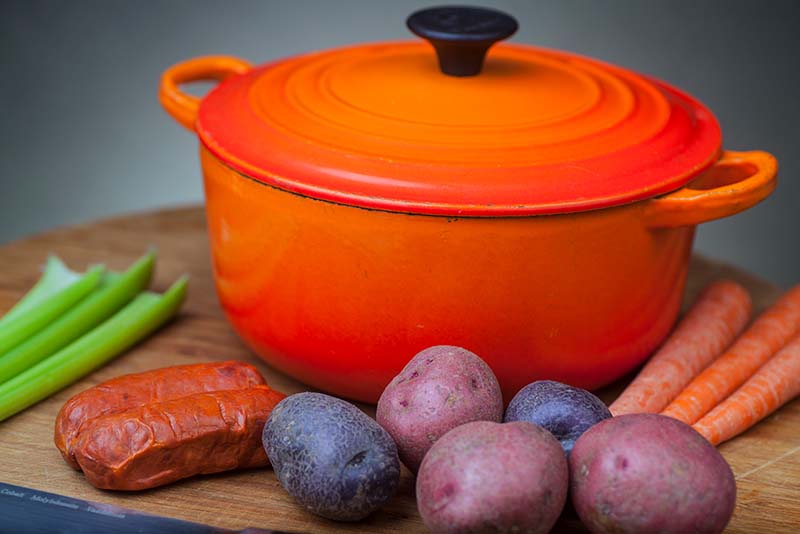
Another great option, and probably slightly superior in certain respects to a regular frying pan, is a deep cast iron pot like a Dutch Oven.
You might be tempted to use the cast iron skillet you already have lying around as a deep frying pan because it seems like it would be a suitable deep skillet, but the fact of the matter is that these pans are just not large enough to hold enough oil to really achieve what you’re looking for from deep frying.
That’s why you should go with a Dutch oven. With a 6 quart pot you’ll be right in the golden range to always have enough oil capacity for whatever you want to deep fry (save perhaps a whole turkey).
Dutch ovens will have the same drawbacks as any other flat bottomed deep frying pan. You run the risk of burning a lot of food right at the bottom and you’ll need to be sure to skim it frequently.
The bonus of cast iron, however, is that it’s really good at retaining heat which in turn makes it easier to maintain the oil at a constant high temperature, even right after you have placed food into the oil.
If you’re looking for something a bit more stylish and even a bit easier to clean, you might consider an enameled cast iron Dutch oven. Enameled cast iron pots won’t give you a huge improvement over regular cast iron, but they are slightly better at heat distribution due to their enamel coating.
And of course, neither cast iron nor enameled cast iron are dishwasher safe and should only be washed by hand.
Wok
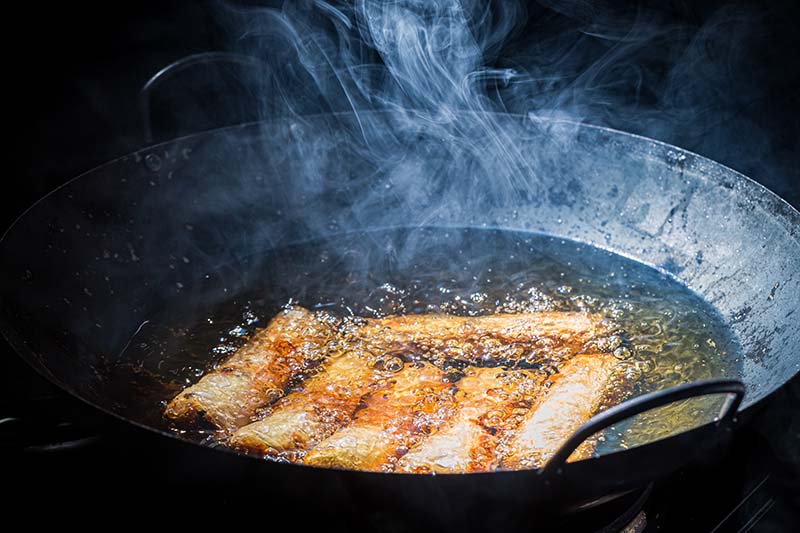
While not usually immediately associated with deep frying, a wok is really one of the best options for deep frying at home.
There’s a whole host of reasons why woks are so good at deep frying.
Their trademark long sloped sides help keep oil from either boiling over or splattering out on the cooking surface. When the oil pops, it just lands on the large sides of the wok and runs back in.
A wok’s shape is also specifically designed to make it easier to move food around inside of it. This makes it a breeze to agitate or flip food while its cooking to sure a consistent end product.
Woks are also fantastic at shallow frying and saving you money on oil. Since the base of the wok is narrower than the mouth, you can easily put only a small amount of oil in it to cook things like crispy onions or small pieces of meat.
The rounded base also makes it particularly easy to scoop out all the leftover burnt debris, since it all collects right at the base and isn’t spread around like in a flat bottomed pan.
Basically, it all comes down to the sloped sides vs the classic straight sides of deep skillets or other pots and pans. The wok’s unique shape is what gives it an edge.
A wok like this traditional handcrafted 14-inch round-bottomed wok is a great option. Made of high quality carbon steel that’s thin and light, it can still handle extremely high heat while heating up very rapidly.
Just remember that if you go with a round bottom wok, you need to make sure you have the right burner set up for it. If you’re just planning on using it on a regular stove, go with a flat bottomed wok.
A flat bottomed wok is a perfectly acceptable substitute. Yes, with the large surface area of the base you might lose out on the easy to clean shape of a round bottom wok, but you’ll still get the benefit of the flared sides.
Most woks don’t come with lids, though you could buy one. If you’re worried about oil splatter, either get a splatter screen or look at another type of pan with lid.
Home Deep Fryers
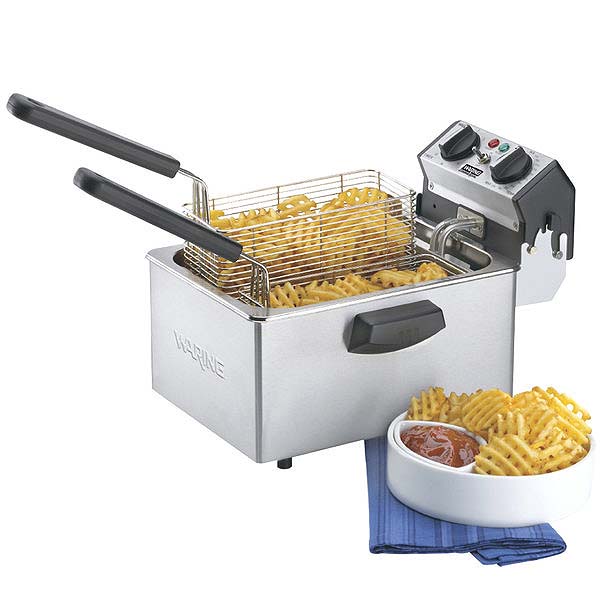
We’re focusing on pans for deep frying here, but it’s worthwhile taking a look at the various types of deep fryers built for home use.
If you’re really looking to replicate the deep-frying experience at home with fry baskets and all, you could consider one.
While they do pretty well as deep fryers and sometimes even include oil filtration systems, they have a fair number of drawbacks.
For starters, they tend to be on the more expensive side, usually running between $100-200 for well built models. This is significantly more than most of the pans on this list.
They also tend to be pretty small, rarely over a 2 quart capacity which makes frying some larger foods in them somewhat difficult.
On top of all that, they have a number of extra interior components that will need to be cleaned semi-regularly and still don’t get quite as hot as the commercial machines.
If you really want that deep frying experience, you can look into getting one of these. Just be aware of the potential drawbacks involved. It’ll streamline your cooking process without a doubt, but will be significantly more complicated to care for than a regular pan.

